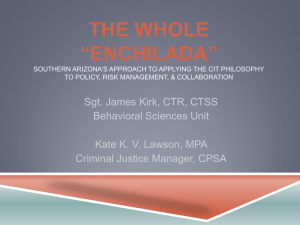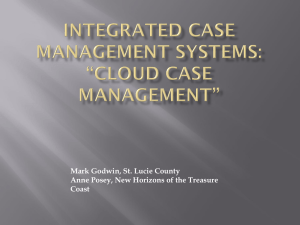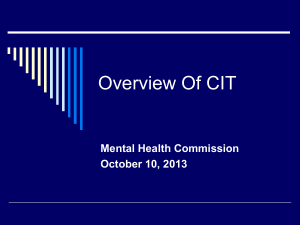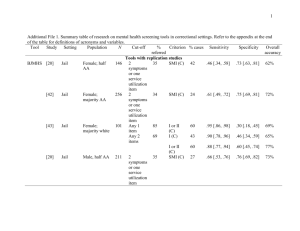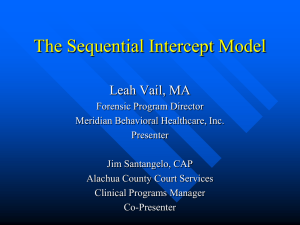Creating and Sustaining a Highly Effective Mental
advertisement
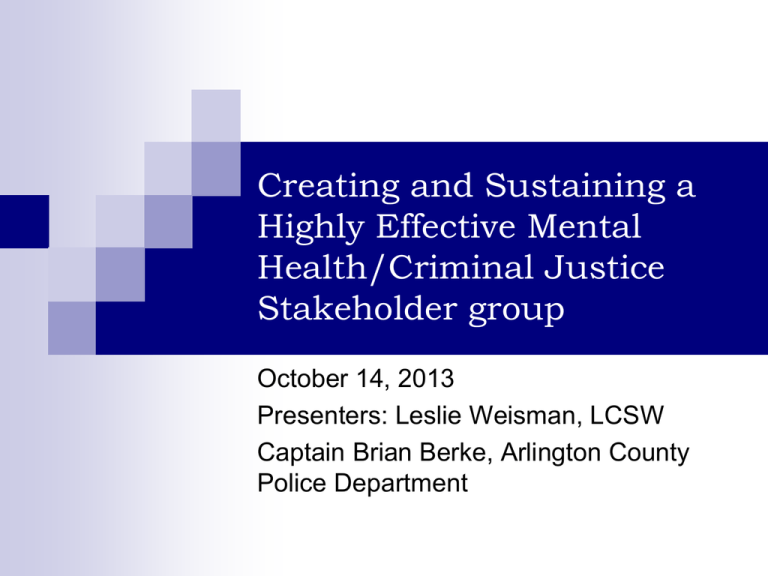
Creating and Sustaining a Highly Effective Mental Health/Criminal Justice Stakeholder group October 14, 2013 Presenters: Leslie Weisman, LCSW Captain Brian Berke, Arlington County Police Department Therapy???? http://www.youtube.com/watch?v=Ow0lr63 y4Mw Objectives Learn the critical partners to include in a mental health/criminal justice stakeholder group and how to engage with these parties; Learn how to set up an action plan that keeps the group on track and moving forward with strategic planning; Learn how to effectively engage all parties to include consumers, family members, and key mental health and criminal justice stakeholders History of Arlington Mental Health Criminal Justice Review Committee (MHCJR) Committee started in May ‘03 in an attempt to look at the process that seriously mentally ill (SMI) people go through in Arlington in terms of the criminal justice system Where do SMI fall through the cracks? Where are new programming or stronger partnerships needed? Original Goals of MHCJR Committee Review current mental health and county jail systems and processes for treating SMI Make recommendations for system improvements to more effectively divert, treat and monitor persons with mental illness who become involved in the system Create effective linkages for mentally ill persons as they leave the jail Implement recommendations Recommendations of the Committee led to system improvements over the past 10 years, new grant funded programs, and a thriving criminal justice/mental health partnership Meetings… Meetings are held monthly for 90 minutes on 3rd Wednesday of every month no matter what... Agenda is developed by our Behavioral Healthcare Division Chief who runs meeting with Crisis Intervention Center (CIC) Bureau Chief Agendas consist of report outs on any kind of forensic (mental health/criminal justice) issue, updates, presentations from county or other jurisdictions Committee Membership Behavioral Healthcare staff, i.e. forensic team, interns, CIT Coordinator, jail based mental health staff, substance abuse staff, senior management Local NAMI representatives Consumer with history of SMI and incarceration Sheriff’s Department Magistrate or designee Public Defender and Sentencing Advocate Commonwealth’s Attorney representative Police Department Community Corrections State Probation and Parole General District Court Judge Year One Spent the year going over the needs and gaps in our mental health and criminal justice systems in terms of best serving the justice-involved SMI Networking, relationship building, roles were defined Year Two Extensive study of non-violent mentally ill in the jail Brainstorming around reducing SMI population in the jail Additional focus: medical clearance process related to Temporary Detention Orders Year Three After two years of looking at needs/gaps in Arlington, committee voted to create a Forensic Case Management/Jail Diversion team Began process of seeking grants to fund the program Year Four Received a $75,000 grant through the Virginia General Assembly for jail diversion (which included requirement of having a stakeholder group) – used dollars to hire a supervisor Received a $70,000 grant from then Dept. of MH, SA and Retardation Services to fund a Jail Discharge Planner for jail based work and discharge planning for restoration patients at state hospital Year Five Received NAMI Northern Virginia award for advancing jail diversion program in our community Began development of a proposal for a Crisis Intervention Center (CIC)(Police drop off center) with CIT trained officers providing security to Emergency Services and Jail Diversion staff and clients. This was particularly critical after the Virginia Tech tragedy. Focus on Mandatory Outpatient treatment along with wide range of comprehensive Crisis Intervention services CIC also will eventually provide 23 hour Office Based Crisis Stabilization Services After several years of groundwork around CIT, our first Arlington CIT training was held for recruits (24 hours) Year Six 2nd CIT training with participants from Police, Sheriff’s Office, Metro Transit Police, and inmate services Initiated Re-Entry Committee in the jail (now meeting bi-weekly for the past 5 years) MH Law Reform Commission, formed after VA Tech tragedy, allocated MH Law Reform dollars throughout Virginia. We received several staff for the CIC through these dollars 3rd CIT training which included Dispatchers Year Seven NAMI Arlington award for accomplishments over past six years Received $259,000 grant from Dept. of Behavioral Healthcare and Developmental Services for implementation of Post-Booking Magistrate Program (2 Master’s degree clinicians, Peer Specialist, and admin.) Received $250,000 one time Federal earmark for DIP (Drunk in Public) project (hired two clinicians) 4th and 5th CIT trainings Year Eight Received four year grant from DCJS for CIT Coordinator Co-location of all “front door” mental health programs as part of development of drop off center 6th, 7th, and 8th CIT trainings Began pilot project called Project Exodus, wrap services around SMI on probation with goal of reducing probation violations and hospitalizations 1st 8 hour CIT Dispatcher training and 1st 4 hour CIT Magistrate training Year Nine 8th and 9th CIT trainings DOC Re-Entry specialists joined Committee Three forensic staff trained at Institute for Law, Psychiatry and Public Policy on conducting Competency to Stand Trial evaluations Year Ten Development of “F-WRAP” groups run by forensic Peer Specialist 10th, 11th, and 12th CIT trainings to include Campus Police from local universities Addition of justice involved peer Feedback from Committee members: Magistrate: “increased my overall awareness and knowledge of mental illness allowing me to develop productive working relationships with individuals in other agencies” “Gave me a ‘bigger picture’ perspective of the mentally ill in the criminal justice system and the positive impact I can make as a magistrate” “Showed me how a stakeholder group can enable different agencies to collaborate, communicate together to successfully solve problems, improve services, and achieve goals in ways that would not be possible operating on their own “. More feedback… Director of Corrections: “…by far one of the best resources available to me as the Director of Corrections…this partnership and the assets gained from the collaboration has been a focal point of our success in the Arlington County Detention Facility.” “The Cmte created the Post-Booking Magistrate Project which allows us to divert non violent arrestees with mental health issues to county services diverting them from often lengthy stays in jail…” “The Cmte has been an important part of our success over the last ten years and continues to be the reason I can sleep easier at night. It has literally transformed the way we think and operate in our facility.” Even more feedback… Chief, Probation and Parole: “The MHCJR Cmte has been invaluable in bringing the heads of all stakeholder agencies together to plan and implement strategies to most effectively deal with the SMI.” “Through such projects as Project Exodus, we have been able to establish collaborative relationships between our line staff practitioners which is where the real results are achieved.” “The Re-Entry Committee, with particular assistance from the Forensic Team and Corrections/Probation and Parole, has been able to conduct reentry planning as envisioned by Governor McDonnell’s Virginia Re-Entry Initiative. Such cooperation has been invaluable in allowing us to plan for the release of people with mental health issues from both prisons and jails that are returning to Arlington County.” Final feedback…. Family member and NAMI representative: “I have been with the MHCJR Cmte since its inception 10 years ago. I have seen all the stakeholders evolve from comparative strangers into a closely knit team with a common goal—to steer persons with SMI into treatment rather than the criminal justice system.” “The results speak for themselves..approximately 40% of the Arlington County Police is now CIT trained and a new grant is helping fund security for the CIC where police drop off those with a seriously mental illness for treatment rather than at the jail for incarceration.” “I’ve observed similar success stories such as the establishment of a drug court and the introduction of mental health programs for the SMI while in jail and on probation. None would have occurred without the existence of the MHCJR.” Final word on the partnership… http://www.comedycentral.com/videoclips/3wn2e4/reno-911--cop-psychology--kimball--pt--2



